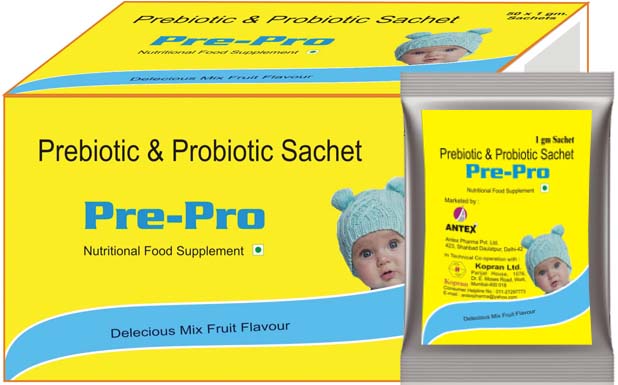SACHET Presentation
Each Sachet contains:Probiotic (Lactobacillus acidophilus,lactobacillus
rhamnosus, Bifidobacterium longum,
saccharomyces bourlardii) 1.25 billion cells
Fructooligosaccharides 100 mg
Probiotics are bacteria that live in your body naturally and help your intestines break down food. Probiotics that are the same or very similar to the ones that your body makes can be taken to supplement healthy digestion. Prebiotics are made up of carbohydrates that your body can’t digest. They exist as food for the probiotic bacteria that you’re putting into your body. The use of prebiotics and probiotics together is called microbiome therapy.
Uses
- Diarrhoea
- Irritable bowel syndrome
- Allergic disorders
- Common cold
- Obesity
- Inflammatory arthritis
- Eczema
- Vaginal yeast infections
- Lactose intolerance
- Urinary tract infections
- Increases gut immunity
Mechanism of Action
Probiotics are live microorganisms that provide health benefits to the host when ingested in adequate amounts. The strains most frequently used as probiotics include lactic acid bacteria and bifidobacteria. Several important mechanisms underlying the antagonistic effects of probiotics on various microorganisms include the following: modification of the gut microbiota, competitive adherence to the mucosa and epithelium, strengthening of the gut epithelial barrier and modulation of the immune system to convey an advantage to the host. Accumulating evidence demonstrates that probiotics communicate with the host by pattern recognition receptors, such as toll-like receptors and nucleotide-binding oligomerization domain-containing protein-like receptors, which modulate key signaling pathways, such as nuclear factor-ĸB and mitogen-activated protein kinase, to enhance or suppress activation and influence downstream pathways. This recognition is crucial for eliciting measured antimicrobial responses with minimal inflammatory tissue damage. A clear understanding of these mechanisms will allow for appropriate probiotic strain selection for specific applications and may uncover novel probiotic functions. The goal of this systematic review was to explore probiotic modes of action focusing on how gut microbes influence the host.Lactobacillus acidophilus is a bacteria that exists naturally in the body, primarily in the intestines and the vagina. Lactobacillus acidophilus has been used in alternative medicine as a likely effective aid in treating diarrhoea in children with rotavirus. Lactobacillus acidophilus has also been used to treat lactose intolerance, Crohn's disease, overgrowth of bacteria in the intestines, or vaginal yeast infections caused by antibiotics.
Lactobacillus rhamnosus is a bacteria that exists naturally in the body, primarily in the intestines. Lactobacillus rhamnosus GG has been used in alternative medicine as a likely effective aid in treating or preventing diarrhea caused by rotavirus in babies and children. This product has also been used as a possibly effective aid in treating colic in babies, and in preventing diarrhea in children that can occur while taking antibiotics.
Bifidobacterium longum are a group of bacteria that normally live in the intestines. Bifidobacteria are commonly used for diarrhoea, constipation, an intestinal disorder called irritable bowel syndrome, for preventing the common cold or flu, and lots of other conditions. Bifidobacteria belong to a group of bacteria called lactic acid bacteria. Lactic acid bacteria are found in fermented foods like yogurt and cheese. They are considered "friendly" bacteria and are taken to grow and multiply in areas of the body where they normally would occur. The human body counts on its normal bacteria to perform several jobs, including breaking down foods, helping the body take in nutrients, and preventing the take-over of "bad" bacteria.
Saccharomyces boulardii is a yeast Saccharomyces boulardii is most commonly used for treating and preventing diarrhea, including infectious types such as rotaviral diarrhoea in children, diarrhea caused by gastrointestinal (GI) take-over (overgrowth) by "bad" bacteria in adults, traveler's diarrhea, and diarrhea associated with tube feedings. It is also used to prevent and treat diarrhea caused by the use of antibiotics.
Fructooligosaccharides when consumed move to the large intestine to stimulate the production of microbiota in the colon and gastrointestinal track. Microbiotas are "friendly, beneficial" bacteria. Microbiotas produce essential nutrients such as short-chain fatty acids; control epithelial cell growth (the cells that line body cavities); prevent overgrowth of infectious organisms; boost intestinal immunity; and prevent inflammation, diarrhoea and other intestinal conditions. This "essential ecosystem" provides an important "balance between health and disease" in the body. Fructooligosaccharides also increase calcium absorption in the body, an important consideration for pre- and post-menopausal women, ages 45 and older, who are losing critical bone mass that increases their risk for osteoporosis and bone fractures.
Side Effects
The product is possible safe for most adults. There is no disadvantage associated with the product if taken under the recommended usage however common side effects include Gas, constipation, loose stool, and loss of appetite sometimes happen, especially at the beginning of the regimen.Know About new DCGI Approved Products
Copyright © by Alaina Pharma. All rights reserved.
Created by Alaina Pharma
